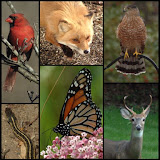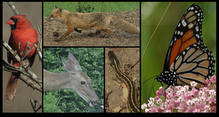 Over the last ten days, this raccoon has visited the Colvin Run Habitat on three occasions. On two of these occasions, I was able to capture these photos.
Over the last ten days, this raccoon has visited the Colvin Run Habitat on three occasions. On two of these occasions, I was able to capture these photos.
 On all three occasions, he came at about 8 PM and ate sunflower seeds that have fallen from the bird feeder.
On all three occasions, he came at about 8 PM and ate sunflower seeds that have fallen from the bird feeder.
 This raccoon appearred healthy and was not threated by my close approach and clicking camera. During his first visit, I took photos out of an opened back porch door. During his second visit, I began by opening the door and easing out onto the porch steps. He didnot react to sounds, but rather to motion that he sees. He looked directly at me for a quick moment, then turned his back to me and continued to eat. During this second visit, I crept barefoot down the steps and along the walkway. He twice raised his head, looked at me, then continued feasting on seed. Finally, I got within 15 feet of the raccoon, where is posed again for photos, then jogged off into the bush. From that close position, I captured the first, third, and last photos.
This raccoon appearred healthy and was not threated by my close approach and clicking camera. During his first visit, I took photos out of an opened back porch door. During his second visit, I began by opening the door and easing out onto the porch steps. He didnot react to sounds, but rather to motion that he sees. He looked directly at me for a quick moment, then turned his back to me and continued to eat. During this second visit, I crept barefoot down the steps and along the walkway. He twice raised his head, looked at me, then continued feasting on seed. Finally, I got within 15 feet of the raccoon, where is posed again for photos, then jogged off into the bush. From that close position, I captured the first, third, and last photos.
 Please make sure that you give raccoons or any wild animals plenty of space, do not threaten the young (even though you may not see them), and do not box them into any corner.
Please make sure that you give raccoons or any wild animals plenty of space, do not threaten the young (even though you may not see them), and do not box them into any corner.
The last raccoon visit occurred 11 months ago.
In the next few posts - the new fawn arrives, bluebird chicks leave the nest, and black snake decides to enter the house.

When I saw him, I began considering the question where was he coming from before sunning himself.
The obvious, but very concerning origin, was inside the house.
Sure enough, as I approached him to take these photos, he began seeking his entrance.
As you can see from these photos, he slipped right in - I believe between the siding and the underlying plywood.

To maintain domestic tranquility, when he returned the next day, I used the sharp blade of a shovel to ensure the this snake never is seen again.




